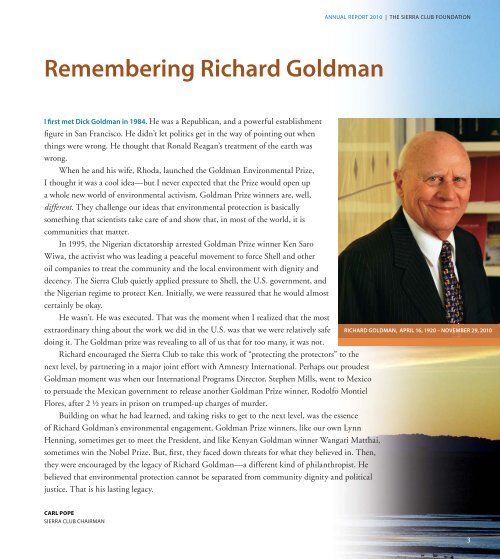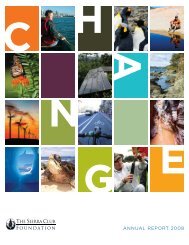2010 Annual Report - The Sierra Club Foundation
2010 Annual Report - The Sierra Club Foundation
2010 Annual Report - The Sierra Club Foundation
Create successful ePaper yourself
Turn your PDF publications into a flip-book with our unique Google optimized e-Paper software.
Remembering Richard Goldman<br />
I fi rst met Dick Goldman in 1984. He was a Republican, and a powerful establishment<br />
fi gure in San Francisco. He didn’t let politics get in the way of pointing out when<br />
things were wrong. He thought that Ronald Reagan’s treatment of the earth was<br />
wrong.<br />
When he and his wife, Rhoda, launched the Goldman Environmental Prize,<br />
I thought it was a cool idea—but I never expected that the Prize would open up<br />
a whole new world of environmental activism. Goldman Prize winners are, well,<br />
different. <strong>The</strong>y challenge our ideas that environmental protection is basically<br />
something that scientists take care of and show that, in most of the world, it is<br />
communities that matter.<br />
In 1995, the Nigerian dictatorship arrested Goldman Prize winner Ken Saro<br />
Wiwa, the activist who was leading a peaceful movement to force Shell and other<br />
oil companies to treat the community and the local environment with dignity and<br />
decency. <strong>The</strong> <strong>Sierra</strong> <strong>Club</strong> quietly applied pressure to Shell, the U.S. government, and<br />
the Nigerian regime to protect Ken. Initially, we were reassured that he would almost<br />
certainly be okay.<br />
He wasn’t. He was executed. That was the moment when I realized that the most<br />
extraordinary thing about the work we did in the U.S. was that we were relatively safe<br />
doing it. <strong>The</strong> Goldman prize was revealing to all of us that for too many, it was not.<br />
Richard encouraged the <strong>Sierra</strong> <strong>Club</strong> to take this work of “protecting the protectors” to the<br />
next level, by partnering in a major joint effort with Amnesty International. Perhaps our proudest<br />
Goldman moment was when our International Programs Director, Stephen Mills, went to Mexico<br />
to persuade the Mexican government to release another Goldman Prize winner, Rodolfo Montiel<br />
Flores, after 2 ½ years in prison on trumped-up charges of murder.<br />
Building on what he had learned, and taking risks to get to the next level, was the essence<br />
of Richard Goldman’s environmental engagement. Goldman Prize winners, like our own Lynn<br />
Henning, sometimes get to meet the President, and like Kenyan Goldman winner Wangari Matthai,<br />
sometimes win the Nobel Prize. But, fi rst, they faced down threats for what they believed in. <strong>The</strong>n,<br />
they were encouraged by the legacy of Richard Goldman—a different kind of philanthropist. He<br />
believed that environmental protection cannot be separated from community dignity and political<br />
justice. That is his lasting legacy.<br />
CARL POPE<br />
SIERRA CLUB CHAIRMAN<br />
ANNUAL REPORT <strong>2010</strong> | THE SIERRA CLUB FOUNDATION<br />
RICHARD GOLDMAN, APRIL 16, 1920 – NOVEMBER 29, <strong>2010</strong><br />
3






